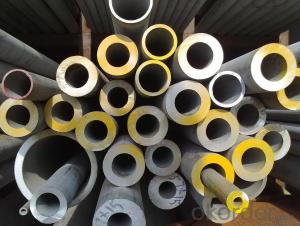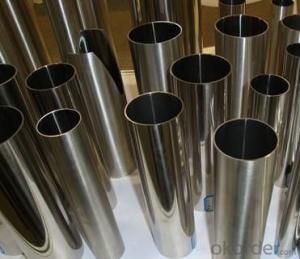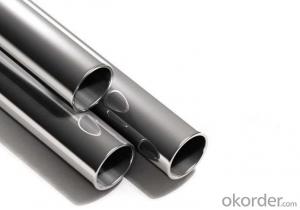Stainless Steel Pipe for Decoration in AISI 201 202 301 304 316 430 304L 316L
- Loading Port:
- China main port
- Payment Terms:
- TT OR LC
- Min Order Qty:
- 5 m.t.
- Supply Capability:
- 100000 m.t./month
OKorder Service Pledge
Quality Product, Order Online Tracking, Timely Delivery
OKorder Financial Service
Credit Rating, Credit Services, Credit Purchasing
You Might Also Like
Item specifice
Standard:
AISI,JIS,GB,BS,DIN,API,EN,ASTM
Technique:
Hot Rolled,Cold Rolled,Cold Drawn,ERW,Forged,Saw,Extruded,EFW,Spring
Shape:
U Channel,Square,C Channel,Hexagonal,Round,Rectangular,Oval,LTZ
Surface Treatment:
Galvanized,Coated,Copper Coated,Color Coated,Oiled,Dry,Chromed Passivation,Polished,Bright,Black,PVDF Coated
Steel Grade:
Q195,Q215,Q235,Q215B,Q235B,RHB335,HRB400,200 Series,300 Series,400 Series,600 Series,SS400-SS490,10#,20#,A53(A,B)
Certification:
ISO,SGS,CE
Thickness:
as required
Length:
12m
Net Weight:
as required

Stainless Steel Pipe for Decoration in AISI 201 202 301 304 316 430 304L 316L
Specifications
| 1) Products | S.S round pipe , SS square pipe , S.S. embossed pipe , S.S. threaded pipe |
| 2) Materials | Grade AISI 304, AISI 201, AISI 202, AISI 301,AISI 316 , AISI 304L , AISI 316L , AISI 430 |
| 3) Standard | ASTM A554, ISO9000 |
| 4) Product range | |
| a) Round and embossed tube O.D. (mm) | 9.5 , 12.7 , 15.9 , 17 , 18 , 19. 1 , 20 , 21 , 22.2 , 23 , 25.4 , 28 , 31.8 , 33, 35, 36, 38.1 , 40 , 41.8 , 42 , 45, 48 , 50 , 50.8 , 56 , 57 , 60, 63.5 , 76.2 , 80 , 89 , 101.6 , 108 , 114 , 127 , 133 , 141 , 159 , 168, 219 |
| b)Square tube side length (mm) | 10*10 , 12*12 , 15*15 , 18*18 , 19 * 19 , 20*10 , 20*20 , 22* 22 , 23* 11 , 23 *23 , 24* 12 , 24*24 ,25*13 , 25*25 , 28*28 , 30*15 , 30*30 , 30*60 , 36*23 , 36*36 , 38*25 , 38*38 , 40*10 , 40*20 , 40*40 ,45*75 , 48*23 , 48*48 , 50*25 , 50*50 , 55*13 , 60*40 , 60*60 , 70*30 , 73*43 , 80*40 , 80*60 , 80*80 , 95*45 , 100*40 ,100*50 ,100*100 , 120*60 , 150*100 , 150*150 |
| c) wall thickness | 0.25 - 3.0mm |
| 5) Length of tube | 3000 - 8000 mm |
| 6) Polishing | 600 grit , 400 grit, 320grit , 240 grit, HL, 2B, BA |
| 7) Term of payment | T / T 30% in advance ,the balance 70% to be paid at delivery . |
| 8) Basic Information | |
| 1) Company Name | Foshan Zaihui Stainless steel product Co., Ltd |
| 2) Business Type | Manufacturer |
| 3) Number of Employees | 300-500 people |
| 4)Factory Size | 46,000 square meters |
| 9)Trade & Market | North America ,South America ,Eastern Europe ,Southeast Asia ,Eastern Europe ,Western Europe |
| 10) Export Percentage | 30% - 50% |
| 11)Application | road lamp facilities , bridge handrail ,expressway railing ,bus stop ,airport and gymnasium . |
| 12) Attention | products all with high quality and competitive price |
| Chemical Composition | 201 | 202 | 301 | 304 | 316 | 430 |
| C | ≤0.08 | ≤0.06 | ≤0.06 | ≤0.06 | ≤0.08 | ≤0.12 |
| S | ≤0.02 | ≤0.02 | ≤0.03 | ≤0.03 | ≤0.03 | ≤0.03 |
| P | ≤0.075 | ≤0.06 | ≤0.045 | ≤0.035 | ≤0.045 | ≤0.04 |
| Mn | 8.5-10.5 | 8.5-10.5 | ≤2.0 | ≤2.0 | ≤2.0 | ≤1.0 |
| Si | ≤1.0 | ≤1.0 | ≤1.0 | ≤1.0 | ≤1.0 | ≤1.0 |
| Cr | 14-15 | 14-16 | 16-18 | 17-20 | 16-18 | 16-18 |
| Ni | 0.8-1.2 | 4--6 | 4--7 | 8--12 | 12--16 | ≤0.05 |
- Q:What is the difference between sanitary and industrial stainless steel pipes?
- The primary distinction between sanitary and industrial stainless steel pipes lies in their intended purposes and the level of cleanliness needed. Sanitary stainless steel pipes are specifically designed for use in industries such as food and beverage, pharmaceuticals, and other environments where cleanliness and hygiene are crucial. These pipes are manufactured with a higher degree of surface finish, typically smooth and polished, to prevent bacterial growth and ensure easy cleaning. The inner surface of sanitary pipes is often electropolished to further enhance its smoothness and resistance to corrosion. Additionally, sanitary pipes are often equipped with tri-clamp fittings or other sanitary connections to facilitate easy disassembly for cleaning purposes. On the contrary, industrial stainless steel pipes find application in a diverse range of industries, including manufacturing, oil and gas, chemical processing, and construction. These pipes are usually designed to withstand high pressures, extreme temperatures, and harsh environments. Industrial pipes may have a rougher surface finish and may not require the same level of cleanliness as sanitary pipes. They are often welded or threaded together for assembly and are built to withstand heavy-duty usage. In conclusion, the main differences between sanitary and industrial stainless steel pipes can be found in their intended purposes, surface finish, and the level of cleanliness required. Sanitary pipes prioritize hygiene and easy cleaning, making them well-suited for food and pharmaceutical applications. Industrial pipes, on the other hand, focus on durability and strength to endure demanding industrial environments.
- Q:Can stainless steel pipes be anodized?
- No, stainless steel pipes cannot be anodized. Anodizing is a process used to create a protective layer on the surface of metals, primarily aluminum. Stainless steel already has a naturally occurring oxide layer that provides corrosion resistance, making anodizing unnecessary.
- Q:How do you join stainless steel pipes to other materials?
- There are various methods available for joining stainless steel pipes to other materials, depending on the specific application and requirements. Below are some commonly used techniques: 1. Welding: The most widely used and effective method for joining stainless steel pipes to other materials is welding. Depending on the material and desired joint strength, different welding processes like TIG welding, MIG welding, or stick welding can be employed. Welding ensures a strong and long-lasting bond between the stainless steel pipes and other materials. 2. Flanges: Flanges are frequently utilized to connect stainless steel pipes to other materials when easy disassembly or connection to different equipment is necessary. Flanges are usually made from materials such as carbon steel, cast iron, or even stainless steel itself. These flanges are bolted together, creating a secure joint that can be easily disconnected, as required. 3. Threaded connections: Threaded connections provide another means of joining stainless steel pipes to other materials. This method is commonly used for smaller diameter pipes or situations where easy removal or replacement of the pipes is needed. Threaded connections can be achieved using pipe fittings like couplings, unions, or adapters, which have male and female threads that screw together to form a tight seal. 4. Compression fittings: Compression fittings are an alternative option for joining stainless steel pipes to other materials. These fittings consist of a compression nut, a ferrule, and a body that houses the ferrule. The ferrule is compressed onto the pipe, creating a tight seal when the compression nut is tightened. Compression fittings ensure a reliable and leak-free joint between stainless steel pipes and other materials. 5. Mechanical connectors: In certain cases, mechanical connectors can be used to join stainless steel pipes to other materials. These connectors typically involve clamping or fastening mechanisms that secure the pipes together without the need for welding or threading. Mechanical connectors are suitable when disassembly and reassembly are required. When selecting the appropriate method to join stainless steel pipes to other materials, it is crucial to consider the specific application, material compatibility, and the required strength and durability of the joint. Consulting with a professional or referring to industry standards and guidelines is recommended to ensure a proper and reliable connection.
- Q:Can stainless steel pipes be welded to other materials?
- Indeed, the welding of stainless steel pipes with other materials is a possibility. Nevertheless, the effectiveness and feasibility of the welding procedure may differ depending on the particular materials at hand. Prior to embarking on the welding endeavor, it is crucial to take into account factors such as the composition, thickness, and intended usage of the materials. Furthermore, it is imperative to employ appropriate welding methods and equipment to guarantee a robust and long-lasting connection between the stainless steel pipe and the alternative material.
- Q:Can stainless steel pipes be used for chemical reactors?
- Indeed, chemical reactors can utilize stainless steel pipes. Stainless steel emerges as a favored selection for chemical reactors primarily because of its remarkable corrosion resistance properties. It exhibits an exceptional ability to resist chemical reactions and endure the severe conditions and corrosiveness associated with numerous chemicals employed in industrial procedures. Furthermore, stainless steel showcases remarkable strength and durability, rendering it appropriate for managing high-pressure and high-temperature scenarios frequently encountered in chemical reactors. Moreover, stainless steel can be effortlessly cleaned and maintained, a critical aspect in preserving the purity and integrity of the chemicals being treated. All in all, stainless steel pipes prove to be a dependable and effective option for chemical reactors.
- Q:What is the difference between 430 and 316 stainless steel pipes?
- The main difference between 430 and 316 stainless steel pipes lies in their composition and properties. 430 stainless steel is a ferritic stainless steel that contains chromium, which gives it good corrosion resistance. However, it is not as resistant to corrosion as 316 stainless steel. It also has lower nickel content compared to 316 stainless steel. On the other hand, 316 stainless steel is an austenitic stainless steel that contains both chromium and nickel. It has excellent corrosion resistance, making it suitable for various applications, including marine environments, where it is exposed to saltwater and other corrosive substances. It also has higher tensile strength and creep resistance compared to 430 stainless steel. In terms of appearance, 430 stainless steel has a dull, brushed finish, while 316 stainless steel has a bright, reflective finish. Considering these differences, the choice between 430 and 316 stainless steel pipes depends on the specific application and the level of corrosion resistance required.
- Q:How do you prevent noise transmission in stainless steel pipes?
- There exist various effective techniques for preventing noise transmission in stainless steel pipes. 1. Insulation: An effective and commonly used method for preventing noise transmission involves insulating the stainless steel pipes. To absorb and dampen sound waves, insulation materials like mineral wool, fiberglass, or foam can be wrapped around the pipes. This helps in reducing the noise transmitted through the pipes. 2. Vibration isolation: Noise transmission can also be minimized by utilizing vibration isolation techniques. This method entails the installation of flexible connectors or rubber mounts between the pipe and its supports. These isolators absorb vibrations and prevent them from being transmitted as noise through the pipe. 3. Anti-vibration pads: Another approach to prevent noise transmission is the use of anti-vibration pads. These pads are placed beneath the pipe supports to absorb vibrations and prevent their transmission as noise. They act as a barrier between the pipe and its support, significantly reducing noise transmission. 4. Acoustic lagging: The technique of applying a noise-reducing material directly onto the surface of the stainless steel pipes is known as acoustic lagging. This material, often composed of mass-loaded vinyl or rubber, acts as a barrier to block the transmission of sound waves. It effectively reduces noise transmission and can be combined with insulation for improved results. 5. Proper pipe routing: Minimizing noise transmission can be achieved by ensuring proper pipe routing. Pipes should be installed in a manner that reduces contact or proximity to other structures or surfaces that can amplify noise. Additionally, avoiding sharp bends or angles in the pipe can help in reducing noise transmission. It is important to consider that the choice of method may vary based on the specific noise issue and environment. Seeking guidance from a professional acoustic consultant or engineer is recommended to determine the most suitable solution for a particular situation.
- Q:Are stainless steel pipes suitable for underground applications?
- Indeed, underground applications are well-suited for the utilization of stainless steel pipes. Renowned for its remarkable resistance to corrosion, stainless steel proves to be an exceptional selection for installations that are situated beneath the surface, where pipes are regularly exposed to moisture, soil, and other detrimental elements. Its ability to endure harsh environments while maintaining its structural integrity over time is truly impressive. Moreover, stainless steel pipes possess superior strength and durability, enabling them to withstand the immense pressure and stress associated with being buried underground. Furthermore, the non-reactive nature of stainless steel ensures that the water or fluid flowing through these pipes remains uncontaminated. Overall, stainless steel pipes can be relied upon as a dependable and long-lasting solution for underground applications.
- Q:Are stainless steel pipes suitable for water desalination plants?
- Yes, stainless steel pipes are suitable for water desalination plants. Stainless steel is an excellent material choice for water desalination plants due to its corrosion resistance, durability, and hygienic properties. These pipes are highly resistant to rust, corrosion, and scaling, ensuring a long lifespan and minimal maintenance requirements. Additionally, stainless steel pipes do not leach harmful substances into the water, making them safe for use in desalination plants. Their high strength and pressure-bearing capacity also make them ideal for handling the high-pressure environments commonly found in water desalination processes. Overall, stainless steel pipes provide reliable and efficient water transport in desalination plants, contributing to the production of clean and safe drinking water.
- Q:Can stainless steel pipes be used for high-temperature applications?
- Yes, stainless steel pipes can be used for high-temperature applications. Stainless steel is known for its excellent heat resistance properties, making it suitable for various industries that require pipes to withstand high temperatures. The high chromium content in stainless steel helps it to form a protective layer of chromium oxide on the surface, which prevents oxidation and corrosion even at elevated temperatures. Additionally, stainless steel pipes have high strength, good mechanical properties, and are resistant to thermal expansion and contraction, making them ideal for high-temperature applications such as power generation, chemical processing, oil and gas, and many other industries.
1. Manufacturer Overview |
|
|---|---|
| Location | |
| Year Established | |
| Annual Output Value | |
| Main Markets | |
| Company Certifications | |
2. Manufacturer Certificates |
|
|---|---|
| a) Certification Name | |
| Range | |
| Reference | |
| Validity Period | |
3. Manufacturer Capability |
|
|---|---|
| a)Trade Capacity | |
| Nearest Port | |
| Export Percentage | |
| No.of Employees in Trade Department | |
| Language Spoken: | |
| b)Factory Information | |
| Factory Size: | |
| No. of Production Lines | |
| Contract Manufacturing | |
| Product Price Range | |
Send your message to us
Stainless Steel Pipe for Decoration in AISI 201 202 301 304 316 430 304L 316L
- Loading Port:
- China main port
- Payment Terms:
- TT OR LC
- Min Order Qty:
- 5 m.t.
- Supply Capability:
- 100000 m.t./month
OKorder Service Pledge
Quality Product, Order Online Tracking, Timely Delivery
OKorder Financial Service
Credit Rating, Credit Services, Credit Purchasing
Similar products
New products
Hot products
Hot Searches
Related keywords


































